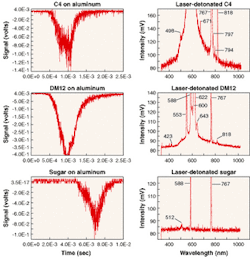Structuring boosts OLED efficiency
A team of researchers from the University of Exeter (Exeter, England) and Qinetiq (Malvern, England) has shown that up to 45% of light lost in small-molecule organic light-emitting diodes (OLEDs) is due to surface-plasmon (SP) modes, and that more than half of this could be reclaimed by using a microstructured device cathode. This could eventually increase output coupling from 20% to 47%. Though loss to SP modes has been recognized in the past, the researchers say their recent study represents the first attempt to qualitatively explore the potential for improving OLED efficiency in this way.1
Surface-plasmon modes are evanescent waves that occur at the interface between a dielectric and a metal. Though such modes are currently being investigated for potential use in integrated optical devices, in more-conventional optoelectronics they can be a problem. Instead of being absorbed and then emitted as light, many of the excitons produced through electron injection are trapped as energy being passed from electron to electron along the surface of the interface. As a result of the strongly localized nature of the SP mode, the energy does not travel very far before being absorbed. Essentially, the excitons are quenched and thus are lost to light production.
Drawing on their strong interest in surface plasmons and other near-field phenomena, the researchers adapted an existing model of loss due to surface plasmons so that it incorporated the effects of material dispersion, absorption and birefringence. This approach, they say, allows them to consider power lost via different optical modes within a planar multilayer structure.
Two types of generic device were considered: one small-molecule system based on aluminum tris-8hydroxyquinoline (Alq3) and a conjugate polymer system in which poly(2-methoxy, 5-(2'-ethyl-hexyloxy)1,4-phenylenevinylene), more commonly known as PPV, was chosen as being typical of its class. What they found was that the loss to surface plasmons was much greater in the small-molecule case. This effect is mainly due to the difference in the orientation of the dipole moments related to the excitons. In the polymer, the spin-casting process means the dipole moments lie in the plane of the film. Since the electric field related to the surface plasmon is mainly perpendicular to this plane, there is minimal coupling between the two modes.
In the small-molecule case, in contrast, there is no preferred orientation. Thus, most molecules will have at least some perpendicular component to their orientation. Further, the quenching of the exciton modes in this system is not limited to the thin (20-nm) layer adjacent to the metal, which would normally be considered the most significant in the consideration of SP modes. On the contrary, researchers found that the entire emissive region was affected by the SP modes, with the thin layer being less affected because, at these small distances, organic-to-metal exciton transfer dominates.
To reduce the losses produced by surface plasmons, the researchers have been looking at using SP-manipulation techniques in the design of their OLEDs. In one experiment, for instance, they used microstructured glass as the substrate for their multilayer small-molecule OLED structure (see figure). In both the TE and TM polarization modes, dramatic increases in output intensity were found for the spectra related to the SP modes. To release even more of the trapped energy, the group is also looking at other approaches: for instance, using subwavelength holes in a thick metal surface or using other kinds of textured, but continuous, surface profiles.
REFERENCE
- Peter A. Hobson et al., Adv. Materials 14(19), 1393 (Oct. 2, 2002).

